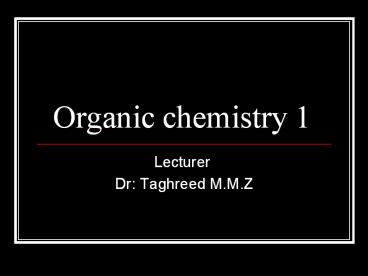Organic chemistry 1 - PowerPoint PPT Presentation
1 / 21
Title:
Organic chemistry 1
Description:
Organic chemistry 1 Lecturer Dr: Taghreed M.M.Z Organic chemistry References which may be helpful: T.W. Graham Solomons Organic Chemistry Sixth Ed., 1996, John ... – PowerPoint PPT presentation
Number of Views:1055
Avg rating:3.0/5.0
Title: Organic chemistry 1
1
Organic chemistry 1
- Lecturer
- Dr Taghreed M.M.Z
2
Organic chemistry
- References which may be helpful
- T.W. Graham Solomons Organic Chemistry Sixth
Ed., 1996, John Wiley, New York. - L.G.Wade, JR. "Organic chemistry" third ed.,1995,
Prentice Hall international, Inc., USA - Robert. V. Hoffman Organic Chemistry An
intermediate Text Second Ed., , Wiley
enterscience, New Jersey. - Edward E.Burgoyne "A short course in organic
chemistry" - Howard, N. "Schaum 's outline of theory and
problems of organic chemistry" third
edition,1999, McGraw-Hill, New York. - R.T.Morrison and R.N.Boyd "organic chemistry"
fifth ed., 1987,Allyn and Bacon, Inc.,Boston.
C
3
Course objectives
- Have an idea about structural theory of organic
compound. - Know main functional groups of organic compounds
- Know main physical and chemical characteristics
of different functional groups. - Have an idea about different reaction mechanisms
involved in organic reactions. - Get experimental experience in dealing and
identifying organic compounds. - Know some important applications of organic
chemistry in our daily life.
4
Course overview
- Structure and chemical bonds
- Important organic compounds will be studied
(physical and chemical characteristics, methods
of preparation) such as the following - Alkanes and Alkyl halides
- Alkenes and Alkynes
- Alcohols and ethers
- Carbonyl compounds
- Aldehydes and ketones
- Carboxylic acids an their derivatives
5
Exams and activities
- Mid-term exam 20 points
- Attendance and activities 10 points
- Lab 30 points
- Final exam 90 points
6
Carbon compounds and chemical bonds
- Definition Organic chemistry is the chemistry of
compounds containing carbon and hydrogen. - What is so special about carbon?
- Applications of organic chemistry
- ? Medicine ? Petroleum industry
Environmental issues - ? Textile industry ? Human metabolism Plastics
and polymer - ? Petrochemicals ? Genetic science.
7
Main characteristics of organic compounds
- ? Organic compounds are flammable and can easily
be decomposed to gases in case they do not
contain metals in their structure. - ? In general chemical reactions of organic
compounds are slow. - ? Some organic compounds contain high amount of
halogens e.g. (X F, CL, Br, I,). - ? Organic compounds have a high content of
halogens tend to be less flammable
8
The Structural Theory of Organic Compounds
- Principal quantum number, (n) n1,2,3
- Angular momentum number (m)0 to (n-1)
- Magnetic quantum number (?) (- ? to ?)
- Spin quantum number(-1/2 to ½)
9
The Structural Theory of Organic Compounds
- Orbital (atomic)- An orbital is a three
dimensional region around the nucleus where there
is a high probability of finding an electron. - n1 1s
10
The Structural Theory of Organic Compounds
- n2 2s 2p
11
Important rules for electronic configuration
- Orbitals are filled in the order of increasing
energy. - Each orbital can only be occupied by a maximum of
two electrons and must have different spin
quantum numbers (Opposite spin) . - The most stable arrangement of electrons in
orbitals is the one that has the greatest number
of equal spin quantum number (Parallel spins).
12
The order of which orbitals are filled
13
Electron configuration
- Definition of atomic number-Z of an element is
the number of protons within the nucleus of an
atom if that element in a neutral atom, the
number of protons and electrons are equal and the
atomic number number of electrons.
14
Electron configuration
- Example Write the electron configuration of
period 2 of periodic Table - Atom Li Be B C N O F Ne
- Atomic number 3 4 5 6 7 8 9 10
15
Types of chemical bonds
- The ionic "electrovalent" bond, formed by the
transfer of one or more electrons from one atom
to another to create ions. - The covalent bond, a bond that results from
sharing of electrons. - "The central idea in their work (ionic, covalent
bond) on bonding is that atoms without the
electronic configuration of a noble gas generally
react to produce such a configuration"
16
Ionic bond "electrovalent bond"
- Electronegativity- is a measure of the ability
of an element to accept electrons. - Li Be B C N O F (period 2)
- Increasing electronegativity
- F Cl Br I (group)
- Decreasing electronegativity
17
Ionic bond "electrovalent bond"
18
Ionic bond "electrovalent bond"
Helium configuration
Neon Configuration
19
Ionic bond "electrovalent bond"
- Ionic bonds form between metals and nonmetals.
- Ionic compounds tend to be crystalline solids
- High melting points may reach 1000?C
- Soluble in water their solution conduct
electricity because the ion can carry the current
through the solution .
20
Covalent Bonds
- Covalent bonding occurs because the atoms in the
compound have a similar tendency for electrons
(generally to gain electrons). This most commonly
occurs when two nonmetal bond together. Because
both of the nonmetals will want to gain electrons
the elements involved will share electrons in an
effort to fill their valence shell.
21
Covalent Bonds































